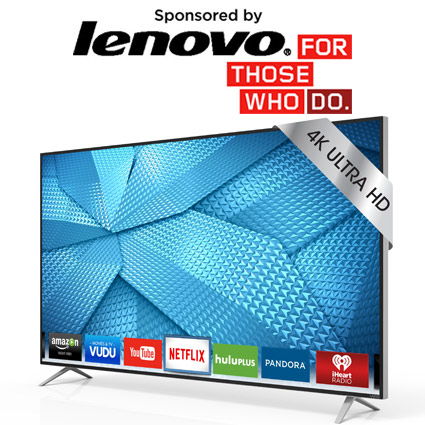
By Gary M. Kaye
Chief Content Officer Tech50+ (www.tech50plus.com)
The year was 1966 when the group Los Bravos released the single “Black is Black,” which hit number four on the U.S. Billboard chart. Fifty years later, this could the television industry’s theme song. Recently I’ve seen new televisions from Sony, Samsung, LG, and Vizio and for each, the big selling point is “black.” Manufacturers all claim theirs is the blackest black, the basis for generating scintillating colors. Each also claims it makes the ultimate in Utra High Definition TV, known variously as UHD-TV or 4K TV.
Is Bigger Better?
Do you remember when 19-inches was a respectable T.V. size? I recently saw a 110-inch diagonal set from Vizio. And while size certainly matters for these sets, that’s not where the gimmicks end. Samsung and LG are still touting their curved sets, some which can actually be adjusted from flat to curved. Most industry experts have been pretty dismissive of curved sets as, well, a gimmick. I like the curve – it makes it easier to see the set from off-axis viewing perspectives. And the shape can cut down on glare. I have a sun drenched living room, and watching television mid-day can be challenging. Not so much with the curve.
Smart, Smarter, Smartest?
The major manufacturers have also realized we’re spending more time watching videos from Netflix and YouTube, so they’ve built Internet Connectivity into most sets, even many entry level screens. All of them do the job, but I like the WebOS 2.0 system in the LG televisions. Recently Netflix –one of the few purveyors of 4K content – came out with TV set recommendations. Included were the LG sets, new Sony UHD sets using the Android operating system, and sets from Chinese maker Hisense with built-in functionality from Roku. Noticeably absent were models from Samsung, which recently announced its new line of SUHD high-end sets.
Picture This
Buying a television is about picture, content, and price. The current sweet spot in screen size seems to be the 55 -inch to 65-inch range. That’s where LG is targeting sets using its new Organic Light Emitting Diode (OLED) technology – an improvement over LED, the industry standard. OLED is simply stunning. But it’s been a challenge for manufacturers to create in large formats at mass market prices. I saw the new curved LG OLED set recently and it is gorgeous. Unfortunately, no pricing has been announced for the line, which will be out later this year.
It’s the same for Samsung’s SUHD line, which it says uses “nano-crystals” to create millions of colors. In both cases, expect the new sets will run about $3,000 or more in the larger sizes. Vizio, which is better known for its entry level products, is no slouch when it comes to picture, even with its lower price points. You can get a 55-inch UHD set from Vizio for just under $1,000.
For many of us, the biggest difference between the Viso set and the $3,000 set isn’t going to be picture; it’s going to be price. And remember, prices increase almost exponentially as you get to huge screens; an 80-inch or larger set from Samsung and LG is above $10,000.
The Cart Before the Horse
Considering a 4K television? What are you going to watch on it? The answer – more than a year after UHD TV hoopla started – is not much. Local cable systems aren’t offering 4K programming. It requires too much bandwidth, little is shot in 4K, and most are wary after the 3DTV debacle a few years back. Blu-Ray disk makers are working on a 4K standard, but it won’t be out until later this year. Your option is 4K content from Netflix and Amazon Prime, with Sony poised to announce new streaming 4K titles. Without native 4K content, your new set will simply double the number of lines it scans from existing Hi-Def sources – hardly justification to invest.
My advice – if you don’t need a new television, wait. If it’s time to replace your set, and you think your new one will last seven to 10 years, consider a 4K. Content will catch up; I just won’t predict when. Go to your local Best Buy or Wal-Mart and watch several 4K sets side by side in as glare-free a setting as possible. Then you, too, can determine if Black is Black.
Gary Kaye is the creator of Tech50+ (www.tech50plus.com), the leading website covering technology from the Baby Boomer perspective. Kaye has been covering high tech for more than 30 years with outlets including NBC, ABC, CNN and Fox Business. He is a regular contributor to AARP and other websites on issues regarding the nexus of technology, seniors and baby boomers.